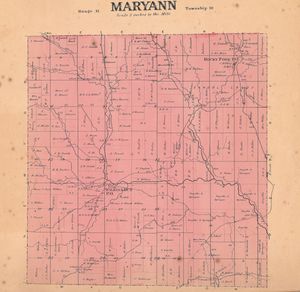Mary Ann Township
The Furnace
The iron ore discovered in the area led to the development of one of the county's first manufacturing centers, the Mary Ann Furnace. Local settler David Moore began preparation for a foundry in 1815 by setting up a saw mill along the Rocky Fork of the Licking River, and followed that with a furnace facility. Two men, Stephen Cooper and Lilburn Wilson, oversaw the project. A grist mill followed the furnace and a small production center had emerged by 1817. The furnace, christened "Mary Ann" after David Moore's wife, would impart its name upon the newly formed township.
Mary Ann Furnace was a successful frontier manufacturing site, supplying local settlers with iron implements, including an ornate stove that became a signature Mary Ann item. Roads leading to and from the furnace led to the rise of a second, albeit short-lived, community in the Township, Wilkin's Run. The success of the smelting induced the development of a village to support and cater to those who worked at the Furnace, growing to a size of around five hundred inhabitants in 1830, roughly half the size of Newark at the time. The local ore vein had dwindled by the 1830s [2] Ore continued to be brought in from other locales by canal and wagon and the furnace continued in operation until a fire destroyed the site around 1853. [3] For many years after the fire that ended Mary Ann Furnace, a large pile of stones could be seen marking the defunct site. [4]
The destruction of the furnace signaled the end of the township's early growth. By 1900 the population had fallen to just 827 [5] In 1940, the total population of the township was 657. [6] The township has seen modest population growth in the last few decades; the 2010 census noted 2,116 inhabitants in the township. [7]
Mary Ann Township and its furnace were fictionalized by author Mary H. Catherwood in Rocky Fork, her novel which drew upon memories of her youth in Licking County. [8]
For more information see also:
Moody, Minni Hite. "Mary Ann's Halcyon Days," The Advocate, January 10, 1969, 3.
Noyes, Edward. "Mary Ann Furnace, Industrial Community of Early Central Ohio," Bulletin of the Historical and Philosophical Society of Ohio. Vol. 9 (1951), 213-226
Smythe, Brandt. Early Recollections of Newark. Newark, OH: Thos. E. Hite Publications, 1940.
J.G.
Return to Townships and Communities main page.
References
- ↑ Hill, N., History of Licking County , (1881), 510-511.
- ↑ Hill, N., History of Licking County, (1881), 511-512
- ↑ Noyes, E., "The Mary Ann Furnace, Industrial Community of Early Central Ohio," Bulletin of the Historical and Philosophical Society of Ohio, Vol. 9 (1951), 222
- ↑ Brister, E., Centennial History, (1909), 358
- ↑ Brister, E., Centennial History, (1909), 248
- ↑ Noyes, E. "The Mary Ann Furnace, Industrial Community of Early Central Ohio," Bulletin, 225
- ↑ https://lickingcounty.gov/civicax/filebank/blobdload.aspx?BlobID=49107
- ↑ Catherwood, M., Rocky Fork, (1882), 73.
